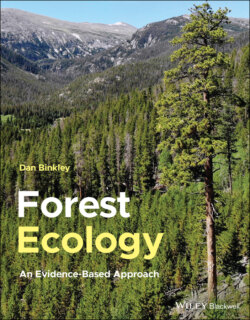Читать книгу Forest Ecology - Dan Binkley - Страница 12
All Forest Ecology Fits Into a Framework and a Method
ОглавлениеWhether a creative idea originated in a concept, an analogy or another line of reasoning, science is incomplete if the idea is not challenged by evidence. The challenge needs to include ways that have a chance to show the idea to be wrong. This book raises questions about how forests work, and examines how the ideas have been challenged by evidence.
A good step for thinking about complex systems is developing a framework for understanding pieces of the system, and how the pieces interact. This book uses a core framework that can be used in every forest at all times (Figure A).
FIGURE A The ecology of all forests can be approached with a core framework and a core method, each asking three questions. The questions apply very generally, while the answers always depend on local details.
The core framework is structured by three simple questions. “What's up with this forest?” leads to familiar methods of measurement. “How did the forest get that way?” can be investigated with a variety of approaches for finding and interpreting historical evidence. “What's comes next?” usually can have only fuzzy answers because the future is not yet written for forests.
This set of core framework questions leads to a second trio of method‐related questions that develop the necessary details to answer the core questions.
1 What is the central tendency (or mean) for this set of objects? (The set could be trees in this forest, forests across this landscape, or the forests at this location across millennia.)
2 How much variation occurs around that central tendency? (Do all trees increase in growth rate across all ages, or do some decline?)
3 What factors help explain when cases fall above (or below) the central tendency? (Are suppressed trees likely to decline in growth rate while large trees continue to increase?)
The core framework and core method may seem a bit awkward or unclear, but they should become clearer (and more useful) as the book uses them to investigate how forests work.
